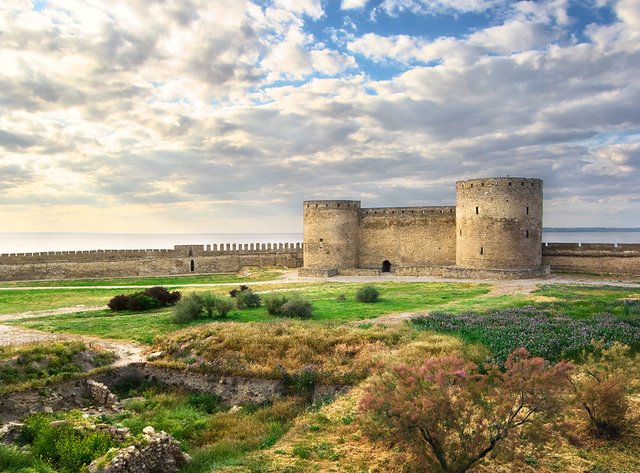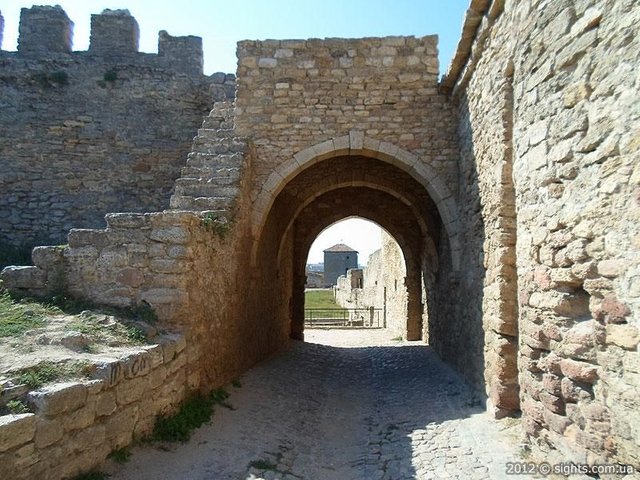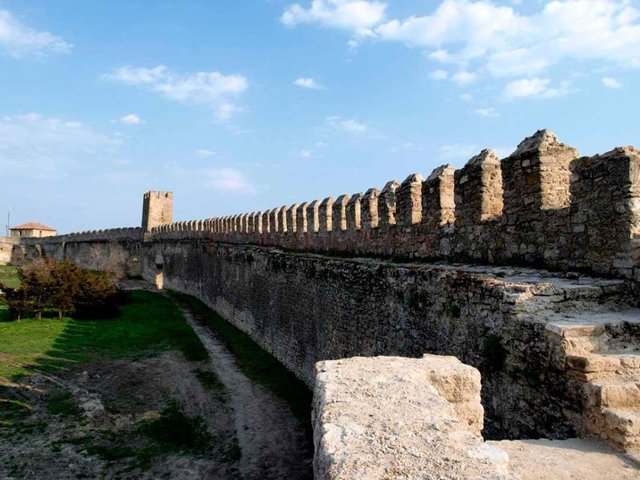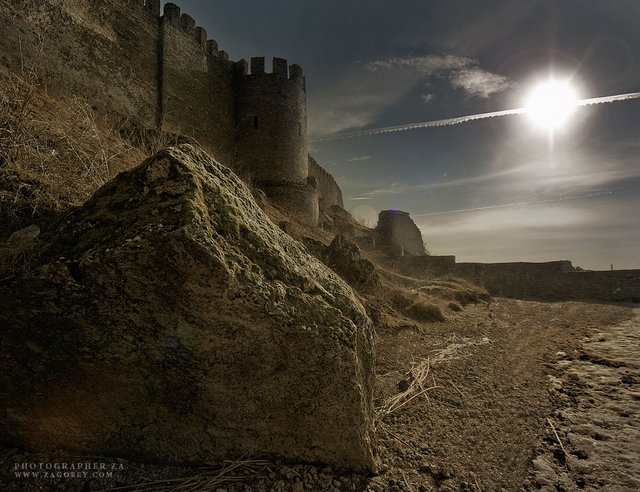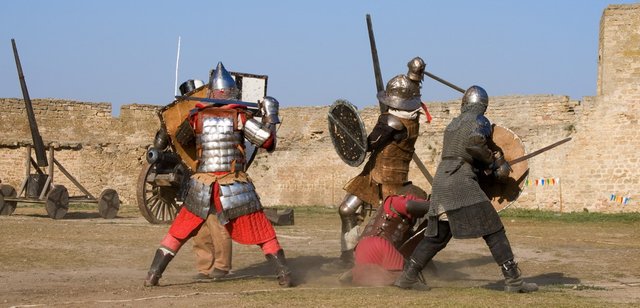In the mid-fifteenth century, the Belgorod fortress was under the rule of the Moldavian Principality and was considered a pillar of its South-East. She covered the main routes into the Kingdom and became part of a fortified network. In 1457-m the defense of the fortress was in charge of Vlaicu, uncle of Bishop of Moldavia Stephen the Great. A few months later, the post goes to Stanula, who was one of the greatest military leaders of the Principality.
The special importance of the citadel was emphasized when, in the period from 1471 to 1474, in the fortress there were two warlord – Bow and Balko. Dual leadership of the fortress was considered to be a recognition that it is valuable for the state. The same was observed later, when from 1475 to 1476 the first year it was run by Herman and Onions.
The attack of Turkish troops in 1475-m forced the commanders to think about strengthening the walls of the fortress. After you have made the decision to build large gates, and a few years later when the Duma and Charmane built another wall. Since that time, the city considered the most important fortification post princes and one of the largest ports. Then at the fortress organized around the protection of the garrison.
Ideal place for building the approach to the construction of the defensive structure of the complex repeatedly saved the residents of the White City from attacks of enemies. In the XV century walls of the citadel was able to withstand a double siege of the army of the Ottoman Empire, which in those days was considered almost impossible.
The fortress played a role in the fifty-year confrontation between the Moldavian Principality and the Ottoman Turkey. However, in 1484, the year the citadel fell under power of the Ottomans.
"Master of the world", the Sultan BAJAZET the Second with his great army could conquer the city. The Turkish forces on land (about three hundred thousand people), with a detachment numbering 50 000 people of Khan Mengli-Girey, and the Marines (almost one hundred ships) tried desperately to capture the fortress. They were filled in the moat dug a new trench for the artillery. After two weeks of fighting and brave defend the fortress capitulated.
BAJAZET II saw how important it can become an impregnable fortress for his Empire. He thought the Ackermann one of the key ports that will pave the way to Russia, Tartary, Poland and the Black Sea.
Whatever it was, many historians concur that the merits in the successful capture of the Turkish generals had. In the Venetian Chronicles Malipiero stated that as delegates to the Turks had sent "five of the best people of the city", who spoke about slabynko fortress. Turkish sources refer to the betrayal of the boyars Belgorod. So, Evliya çelebi, a traveler from Turkey, wrote that the Ottoman army was handed the precious box with the ten keys of the citadel.
It was a severe blow to Moldova, which could affect the fate of the Principality, because the Empire could reach the center of the state within the week. Therefore, in 1484 and 1485, the Prince of Moldova is trying to break unawares settled in the fortress of the Turks and take back your power in the walls, but the Ottoman Port was expecting such action and repulsed the attack. Then, in August 1484 and breaks the line of the Moldovan government in the city and begins a new era of domination of the Ottomans, which lasted for 328 years.
In power of the Ottoman Empire fortification fortress properties were constructed and partially redone. So there was the first Bastion line, built by the best engineers of France, and increased almost all the walls of the citadel. During the reign of Bayazid II is the Christian Church built the first mosque. For many years already, the fortress of Akkerman was listed as the most important strong point North of the Ottoman Empire.
Despite the measures and the numerical army, located on the territory of the citadel, its military story is not over. Since the beginning of the XVI and XVII century, it was with the battle of Zaporozhye and don Cossacks (Ivan Sirko, semen Paliy, Gregory Loboda), even army of the Crimean Tatars under the leadership of Islam II, who was buried in the "big mosque". But until the eighteenth century nobody managed to besiege the castle and take it away from the Ottomans.
Even then, the Russian Empire became a major power in the world, which had a great influence on many countries. Started the first anti-Turkish campaign, and in 1770-m Russia announced itself as a serious opponent. Then the army under the leadership of Igelstrom for the first time in three hundred years, recaptured the fortress from the Ottoman Empire.
However, understanding how the walls of Akkerman important for the state, the Ottomans return the power over the city in four years. A second trip to the walls of the fortress by troops of the Moscow dated 1789, the year. The army headed by the commander of the Potemkin, won back the citadel. Then partly in the battle attended by F. F. Ushakov, Kutuzov, and Barclay de Tolly. The commandant in 1790 was appointed the General-the major of Kutuzov, who organized the exploration and observation of the movements of the Turks in the sea and on land.
In 1812 had been signed the Bucharest Treaty and the southern part of Bessarabia and the Ackerman finally became part of the Russian Empire. Five years earlier began large-scale restructuring of the walls of the fortress, in order to consolidate its fortification properties. But 1832-the year he put the final point in the military history of the citadel of the White City. It was abolished, it ceased to exist as an object of military importance, and its territory was transferred to the custody of the town Council. Since that time the fortress is practically not followed in the 60s, its walls were put up for auction, and even wanted to dismantle the building materials, which is partially successful.
At the end of XIX century, thanks to the Imperial Odessa Society of Antiquity and History Ackerman declared a historical architectural monument. Already in 1900, archaeologists began excavations on these lands, trying to find traces of Thira, an ancient city from which went to the history of this land.
The collapse of the Russian Empire in the aftermath of the October revolution, the fortress passed into the Romanian authorities, under the wing which was from 1918 to 40 years. In the 1927-1928. was organized the restoration of the warehouses and watch towers of the front gate. Restored buttresses, set the beams in place of the rotten, patched the holes and redid the tile roof.
Already 2 August 40 after the victory of the red Army, the County has included in structure of the USSR. 26th July ' 41, the territory was occupied by the German-Romanian troops in the occupation which she remained until the 44th. The release of the territory of the Soviet Union gave him back his former name of Belgorod-Dniester.
Interestingly, despite numerous alterations, repairs and a lot of hostilities, the fortress walls survived, retaining the original design. Nowadays, the Akkerman fortress national treasure powers, which attracts tourists from all over the world. Here are held not only excursions, but also jousting, as well as various festivals of historical reconstruction.
The auth or of the article @vpodessa

